|
Can you help |
|
Can you help |
Every Picture Tells a Story
The Funeral Procession
Bishop's Stortford
[The Deceased has now been identified]
|
Many of the old postcards which come onto the market have lost their provenance and the story they can tell the local and family historian is lost. However sometimes there is sufficient information in the picture to allow at least some of the history to be reconstructed. In May 2007 two postcard were put up for sale on ebay showing a funeral, possibly from Bishops Stortford, and these are used to demonstrate what can sometimes be done to find out more about the subject. |
This will be an interesting test of what can be done from a distance - as I live on the other side of Hertfordshire to Bishops Stortford, and have never visited the town. At least in the early stages all the information will come either from books, or from my computer.
Please tell me if you can fill in some of the gaps
|
Publisher Information The first thing to note is that there is no photographer or publisher information on the cards, but that both have the same back. There are no album marks, and the only writing on the backs is a price in decimal money suggesting that they have been in "sales box" and separated from related "heritage" items for some time. Both cards are damaged - but the stains on the second appear to have occurred during the development of the print - and it is likely that they have been produced by an amateur photographer. If so they may well be a unique record of the funeral. |
Dating the Card Back

A look at the back of the card gives a general indication of the date. The message on the back suggests that the card base could not have been printed before about 1904 (but the photograph could have been developed some years later on old stock). The postage rate applied before 1917. This evidence (although not cast iron) might suggest a date between 1904 and the First World War.
Are the pictures of the same funeral?
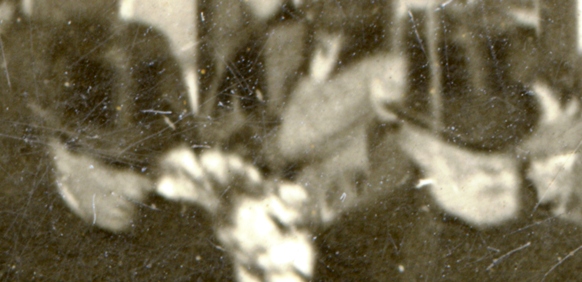 |
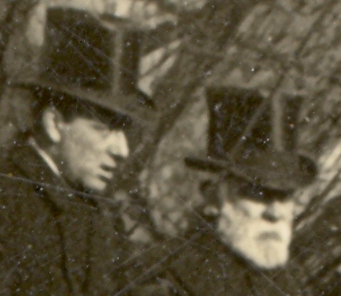 |
A quick look shows that the hearse and the horses look the same and a more detailed look at the driver and his companion (the funeral director?) show they are the same - indicating that is it the same undertaker.
The picture is clear enough to identify the individuals. Can anyone help?
|
|
The arrangement of wreaths along the right side of the
hearse also seem to be the same:
It therefore seem appropriate to consider that they are of the same funeral. |
|
|
|
||
Is it in Bishops Stortford?
 But
is it Bishops Stortford? The first clue is the sign over the shop which reads "Family
FOWLER Butcher".
Kelly's Directories for Hertfordshire are
available on the Historical Directories web site for 1902, 1908 and 1914.
But
is it Bishops Stortford? The first clue is the sign over the shop which reads "Family
FOWLER Butcher".
Kelly's Directories for Hertfordshire are
available on the Historical Directories web site for 1902, 1908 and 1914.
In 1902 and 1908 Frank Fowler, butcher, is listed at 20 North Street & 74 South Street, Bishops Stortford, and he was the only Fowler, butcher, listed in Hertfordshire. In 1914 Frank Fowler, butcher, is listed at 20 North Street; 74 South Street & 1 Dunmow Road & farmer, Parsonage Mill, TN 81.
This suggests that, if it is Hertfordshire, there could be three possible locations within Bishops Stortford, and I will return to that matter later, as there is other, stronger evidence to confirm Bishops Stortford.
What does the poster tell us?
 On the wall of the shop
there is a display of four apparently identical posters and by considerable
enlargement and enhancement it is clear that it is advertising the "EMPIRE
PICTURE PALACE" and the words below, while indistinct are compatible with
"Bishops Stortford".
On the wall of the shop
there is a display of four apparently identical posters and by considerable
enlargement and enhancement it is clear that it is advertising the "EMPIRE
PICTURE PALACE" and the words below, while indistinct are compatible with
"Bishops Stortford".
A search on Google comes up trumps. The Bishops Stortford and Thorley web site has a page on the Cinemas of Bishops Stortford which includes the following:
After the birth of the British Cinema in the 1890s some of the earliest short films may well have been shown in local halls or clubs, but in 1911 a race was on to complete the town’s first cinema. While Bishop’s Stortford Cinema Ltd were busy converting the old Wesleyan Chapel at No 1 South Street (now the site of W H Smiths), another concern was building the Empire Picture Palace at No 20 South Street next to the Working Men’s Club. The former won the race and ‘The Cinema’ opened on 10 February 1912. It was, by all accounts, a quiet and private affair with admission that evening by invitation only.
In complete contrast, the opening of the Empire a few weeks later on 25 March was a much livelier event. The town band played, three films were shown, and the entire days takings of £5. 13s. 9d. (£5. 68) were donated to the Bishop’s Stortford Hospital. But despite the initial publicity, and a small fortune spent on weekly advertising, the Empire wasn’t successful and closed within three years of opening.
In addition the Mercia Cinema web site (a comprehensive list of Cinemas across the country) records:
EMPIRE PICTURE PALACE 20 South Street Opened Monday 25th March 1912. Architect: Houston & Houston. Props., F. A. Dando & C. E. A. Gilbert. Reversed auditorium. Cap. 500 – one raked floor. Closed c.1916. Demolished. Site retail use.
This not only confirms the Bishops Stortford location for the cards but dates the funeral to a period of about three years from March 1912. [For more about the cinema, showing that it was open after April 1915 see South Street. For information about Charles Gilbert see Gilbert, Bishops Stortford c1902-1913,]
When did the funeral take place?
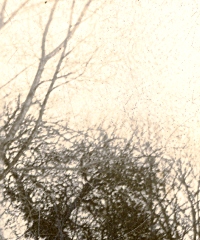 So
we know the date within a couple of years - and have also confirmed that we are
talking about Bishops Stortford. However Frank Fowler had three shops and to
locate the first picture more precisely we need to find out which one. There are
some important clues in the pictures themselves which could be easily overlooked
So
we know the date within a couple of years - and have also confirmed that we are
talking about Bishops Stortford. However Frank Fowler had three shops and to
locate the first picture more precisely we need to find out which one. There are
some important clues in the pictures themselves which could be easily overlooked
 The
second picture shows the hearse passing some houses and in the background it is
clear that the trees and bushes are completely devoid of leaves, telling us that
the funeral took place in winter. Returning to the first picture we can see all
the spectators appear to be warmly dressed, also suggesting winter.
The
second picture shows the hearse passing some houses and in the background it is
clear that the trees and bushes are completely devoid of leaves, telling us that
the funeral took place in winter. Returning to the first picture we can see all
the spectators appear to be warmly dressed, also suggesting winter.
There is a distinct shadow, which is comparatively short suggesting a time around midday with the procession proceeding south.
If the street location can be accurately identified on an ordnance survey map the shadow in the picture could be treated as a gnomon of a sundial, with the direction telling the time and the length the time of year - perhaps to within a week or so although the measurement could not say which side of the winter solstice the picture was taken. (Sorry I give up at this point - but can anyone help?)
The shadows in the second photograph appear to be longer and it could have been taken later in the day, after a church service. This would mean that the horses are going in a generally south westerly direction. A look at modern maps (such as google) suggests that they may be travelling to the cemetery along Apton Road.
So where was Fowler's shop - using old pictures?
The shadows in the first picture locate Fowler's shop on a junction of a main road running north south, and a side road entering from the East. The photo is taken from a comparatively high viewpoint on the west side of the street.
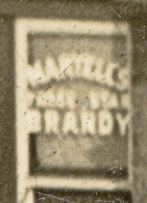 |
The photograph showing the shop includes one important clue about what a neighbouring property sold - an advert for Martell's Brandy in a bay window. So perhaps the answer is to find identify the property - as public houses are comparatively well documented.
To help me decide which it was I decided to look at a number of the books of photographs of old Bishops Stortford (See Sources of Information). Unfortunately I was unable to find any old street scenes of the roads which clearly showed the shop, and few, if any, even gave a clue to the numbering of the properties. Remember Stortford had a picture of "North Street friends" which includes Frank Fowler - but with no indication which of the people in the picture he was. It was clear that significant lengths of the streets, particularly South Street, were not shown in the pictures available to me and Dunmow Road was a dead loss.
So is it North Street?
If the shop was in North Street it would have to be on the East side near an major road junction. Maps fail to show a suitable road junction and the continuous frontage of impressive commercial buildings did not fit either. A check of the 1912 Kelly's Directory provided the following neighbours:
Several of these properties could be identified from the photographs and proved that Fowler's North Street shop was part of the continuous frontage - and could not be the one in the funeral photograph.
or South Street?
If the shop was in South Street it would have to be on the East side near an major road junction. Because of the River, which runs behind the properties on the East side there was only one candidate location - the road that crosses the River to go to the railway station. The books were unhelpful in that they did not show anything that could be linked to this part of the street. A search of the Bishop's Stortford entry in the 1914 Kelly's Directory shows the following entries in South Street:
So Frank Fowler's shop - and the side road shown in the picture - were between two beer retailers. The Bishop's Stortford and District Local History Society booklet Public Houses and Hotels identifies No. 70 as the Sacacen's Head. No. 78 is identified as Bridge House and the description reports that It was opened in 1868, two years after the bridge in Station Road was erected. Before that time it cost ½d to be rowed across the Stort.
Having got some pub names I go back to the Bishops Stortford and Thorley web site - which has quite a bit about Bridge House including some photographs and the news that it burnt down in 2006. The photographs make it clear that even numbers were on the West side of the road - and that Frank Fowler's shop in the photograph cannot be the South Street Shop.
So is it the Dunmow Road Shop?

Hockerill Street and Dunmow Road circa 1883
from large scale O.S. map on
Oldmaps.
 |
So the search switches to a public house in Hockerill near the corner of Dunmow Road and Stansted Road. Another look at the booklet Public Houses and Hotels suggests the Cock in Stansted Road - with a picture which shows part of a shop next door, There is an even better picture in The Book of Bishop's Stortford & Sawbridgeworth (reproduced right). This clearly shows a building that matches the funeral photograph of Mr Fowler's shop adjacent to the start of Dunmow Road, The windows of the Cock have writing on which is too small to identify but could well be the Mantell's Brandy advert of the funeral photograph. [An afterthought - the shadows on the road in this photograph suggest at least a two story building on the corner opposite the shop, which would provide the high viewpoint from which the funeral picture was taken.]
There can be no doubt that the shop in the funeral photograph is Frank Fowler's Dunmow Road shop.
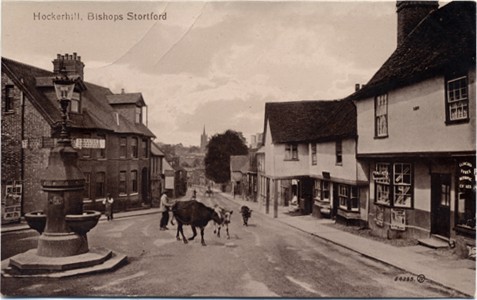 |
A View down Hockerill Street taken by someone standing outside Mr Fowler's Shop
Valentine Card 54255
The Fountain is now in Castle Gardens - see Geograph picture |
So what do we know?
Now we know where the picture is taken we can tell that the funeral procession was travelling south along the Stansted Road. It was almost certainly going straight ahead at the cross road, proceeding along the London Road rather than turning right along Hockerill Street in the direction of St Michael's. As Stansted Road runs slightly East of North, and as the line of the shadow in the photograph is slightly East of North when compared with the buildings, it is definitely in the early afternoon during the winter months. The cinema advertisement shows that the first photograph must have been taken no earlier than March 1912, and almost certainly no later than 1916. The lack of leaves on the trees in the second photographs shows it was in winter.
It is also perhaps worth noting that All Saints Church is on the Stansted Road and the most likely route from the church to the cemetery would be down London Road, crossing the river using Station Road and continuing along Newtown Road to join Apton Road.
What questions are still outstanding?
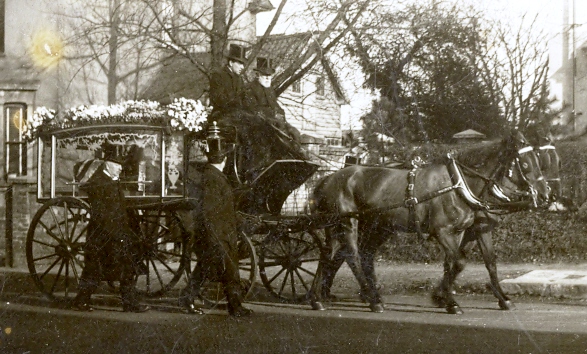
Undertaker: While the photographs are good enough to identify some of the undertaker's men the identity of the firm managing the funeral is unknown. Kelly's Directories are of little help. In 1914 (and 1922) there is no undertaker listed in Bishops Stortford. In 1912 the only entry is for "Charles Martin (exors of), 123 South Street, Bishops Stortford", and this entry probably indicates he had died before the Empire Cinema opened. It may be that the undertaker came in from elsewhere - or that the funeral was put on by a local builder who also did the occasional funeral.
|
Aidan Reynolds (aidanstiggunner @t hotmail.com) of Bishops Stortford writes: I have been researching my family tree for the past 33 years and came upon the Bishop's Stortford Funeral postcards quite by chance. The only information I can tell you is that the Charles Martin of South Street Bishop's Stortford mentioned in your piece is almost certainly my great great grandfather. He was a Builder & Timber Merchant by trade and had a yard on Wharf Road. He died in 1909 although one of his sons did branch out into the funeral business. It is possible that they used Charles' name. . The business appears to have continued until about 1926 as there are references to Charles Martin (exors of), builder, 123 South Street in the 1914 to 1926 Kelly's Directories for Hertfordshire. |
Time and Date: Using measurements of the shadow it should be possible to narrow the dates on which the funeral was held. There may even be computer programs which would make it easy.
Location of Second Photograph: While this may have been on the approach to the cemetery this is not certain - it is unlikely that this could be answered except by someone who has specialist knowledge of Bishop's Stortford's history.
The Identity of the Deceased: It is possible that this question will never be answered - unless some other records relating to the same funeral have survived and can be located. However, there may be clues in the Herts & Essex Observer as the funeral would seem to be of someone who was inportant enough to be reported.
A Possible Identity and Date
Over six months later, while researching another aspect of Bishops Stortford, I found a very likely identity for the deceased, as everything appears to fit the evidence previously collected.
Sir Walter Gilbey, of the firm W & A Gilbey is described in his online biography as "one of the most successful, influential and philanthropic men ever to emerge from Bishops Stortford", died on 12 November 1914, aged 83, and was buried in New Cemetery, Apton Road. He lived at Elsenham Hall, to the north east of Bishops Stortford, and the natural route from Elsenham to the New Cemetery would be to come down the Stansted Road. His status in the town was such that it was likely to attract numbers of people in dark clothing to line the route. One might also expect some people with cameras to take photographs of such a significant event.
For more online information on Sir Walter Gilbey see History of Bishops Stortford, Wikipedia and Oxford Dictionary of National Biography. The Rhodes Art Complex holds a major collection of Sir Walter Gilbey's papers, and there is a whole gallery devoted to Sir Walter Gilbey and the W & A Gilbey Wine Co.
What is needed now is to try and find out more information on Sir Walter Gilbey's funeral, possibly from press reports, to see if this can confirm the identity.
| Were your ancestors in Hockerill in
1914?
If so can you suggest names for anyone in the watching crowd? Several of the faces are clear enough to make this possible. |
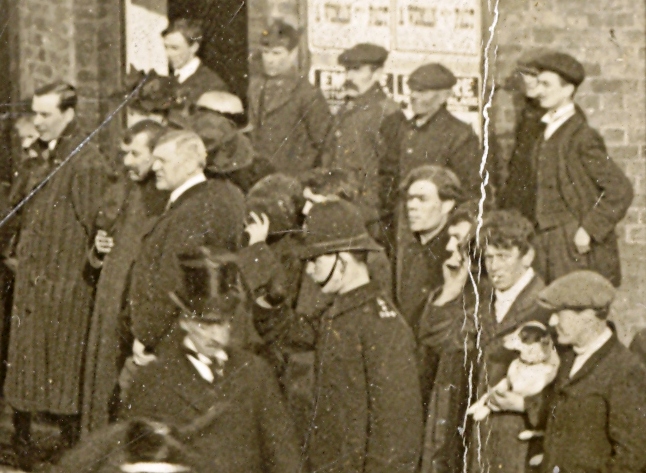 |
Location of 2nd Photograph
David Brown of Bishop's Stortford writes: From the houses - particularly the small gable end you can see behind the house on the left, and the windows in the attic - it is pretty clear that the procession is in London Road just south of the junction with South Street (the Whitepost roundabout). The procession is heading south along London Road and presumably would have turned right up Thorley Hill towards the cemetery. I do know that Walter Gilbey owned some land on the north side of Thorley Hill, which may be relevant.
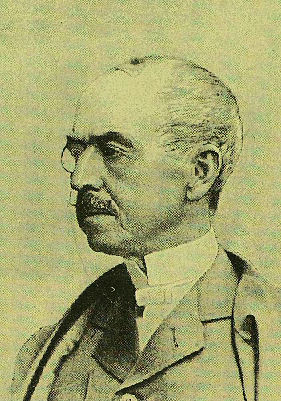 Brief
report of the funeral
Brief
report of the funeral
Court Circular: ... The funeral of Sir Walter Gilbey took place at Bishop's Stortford yesterday. Among those present, in addition to members of the family, were the Earl of Warwick, Lord Blyth, Sir John Barker, Sir Charles Gold, Sir Gilbert Greenall, Sir Ernest Clarke, Sir George Hastings, and Sir J. Roper Parkington.
The Times, 17th November, 1914
Portrait from Illustrated London News
21st December, 1889
The Funeral Identified!!
Jill Vail writes: I have checked the Herts & Essex Observer records for that period. Sir Walter's funeral procession actually entered Stortford via Rye St from his mansion Elsenham and proceeded to St Michaels Church in Windhill before making its way to the cemetery via Potter St and Apton Road. It did not go anywhere near Hockerill thus I am absolutely sure that these postcards portray someone else's funeral. I have also read various reports in the paper about Admiral Frederick Vander Meulen, who died on 13 February 1913, and who was a local magistrate and well known dignitary in Stortford. To support this I have also established that during the week of 15-22 February the Empire Cinema was showing something called "Harry Ashton" which appears to fit with the rather hazy writing on the posters in the photograph. Jill also provided the following detailed notes and a modern photograph:
Admiral Frederick Samuel Vander-Meulen
Admiral Frederick Samuel Vander-Meulen was the son of the Rev. Frederick Vander Meulen, a former rector of Thorley just outside Bishop’s Stortford. He entered the navy in 1853 when he was just 13 and was destined to take part in active service when the war with Russia broke out in 1854 as a cadet in the Furious, a 16-gun frigate stationed in the Mediterranean. He was present at all the operations before Odessa at the attack on the Sebastopol forts on 17 Oct 1854. He was awarded the Crimean and Turkish Medals and became midshipman with further service in China on the 70-gun ship Sans Pareil. He was present at the capture of Canton and the attack on Namtow which brought him the China medal. He was promoted to Lieutenant in 1870, to commander in 1871 and captain in 1878. He commanded the Dido on the North American Station from 1883 to 1886, the Devastation coastguard ship at Queensferry from 1887 to 1890. He rose to be the senior captain in the navy and was promoted to rear-admiral in1893 the day after the disastrous loss of the battleship Victoria off the coast of Syria. He replaced Sir George Tryon who was in command of the Mediterranean fleet and who died in the sinking of his flagship. Frederick Vander-Meulen was promoted to Admiral, on the retired list, in 1904.
He retired to his house in Stansted Road, Bishop's Stortford and became an active member of the community serving as a magistrate, following in the footsteps of his father and grandfather. Between the three of them they had an unbroken service as magistrates of nearly 100 years. He was also a manager of All Saints Boys School and an active member of All Saints church congregation. Following Sir Walter Gilbey Bart’s generous gift to the town of a block of almshouses in 1905, he funded the building of a further two blocks of ‘Kings Cottages’, one in memory of his brother Colonel John Harrison Vander-Meulen 'for the poor aged persons of Thorley’. Applicants had to be at least 60 years of age and have resided in the parish for at least 20 years, a requirement which remains today. Unfortunately, the 1907 block is best remembered because the King’s profile was set to face the right rather than the left which some say must have been an embarrassment.
 |
The Cortège passed in February 1913 |
|
|
The Same View in 2014 by Jill Vail
click on picture for wider view |
Vander Meulen died on Thursday, 13 February 1913, aged 73, and was interred in Thorley Churchyard the following Tuesday, where several of his relatives are buried and his father was Rector. The funeral cortege left the residence of the deceased on Stansted Road shortly after half-past two, where respectful crowds gathered in the vicinity and also at the top of Hockerill Street (to which the postcards bear witness), the bell at All Saints Church tolled throughout, the church where the Admiral worshipped for so many years was open for private devotions as usual. Along the route of the procession business premises were closed and blinds drawn at all private residences a tribute to the respect and esteem. The coffin was enshrouded in the Union Jack, upon which was borne the deceased’s cocked hat and sword. The chief mourners followed and these included his nieces and cousins, his housekeeper and gardener. Interestingly, the Herts & Essex Observer’s article mentions that Mr Walter Gilbey, unable to be present at the last rites due to the bitterly cold weather, followed in his closed car. (Walter of course was by now over 80 and died the following winter). On arrival at the churchyard gates at Thorley Church the procession was met by J E J Proctor, rector, and the coffin was followed by a large number of the deceased’s friends and acquaintances and townspeople,; these included Sir John Barker, Bart, Col G.B. Archer Houblon, Col Healey, Mr Tresham Gilbey and members of the town council.
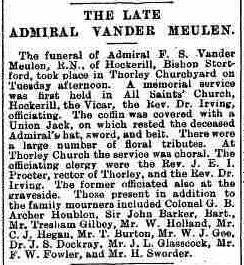
|
|
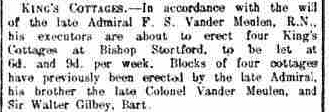 Herts Mercury, 7th June, 1913
|
|
 |
|||
| 21st February 1913 | 14th February 1913 | 8th August 1913 | |
| Chelmsford Chronicle | |||
Walter Gilbey worked at Tring as a young man - See Auctioneer's Apprentices in Tring, 1828-1848
If you can add to the information given above tell me.
| July 2008 | page updated | |
| December 2009 | Minor corrections | |
| May 2010 | Update re Charles Martin, possible undertaker. | |
| October 2012 | David's identification of photo | |
| January 2014 | Funeral identified | |
| February 2015 | Link to Tring | |
| March 2015 | Added Chelmsford Chronicle Press Reports |